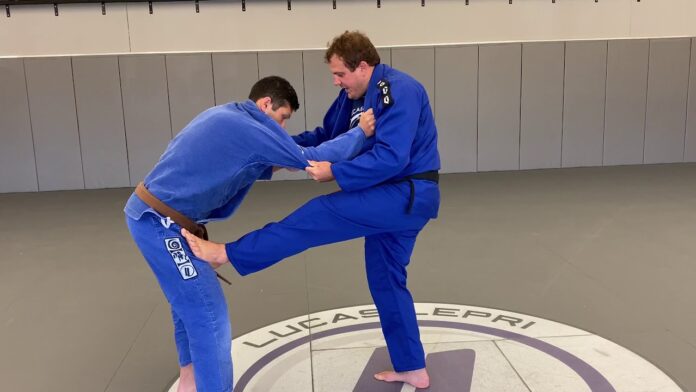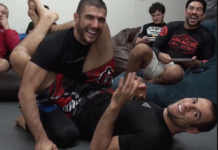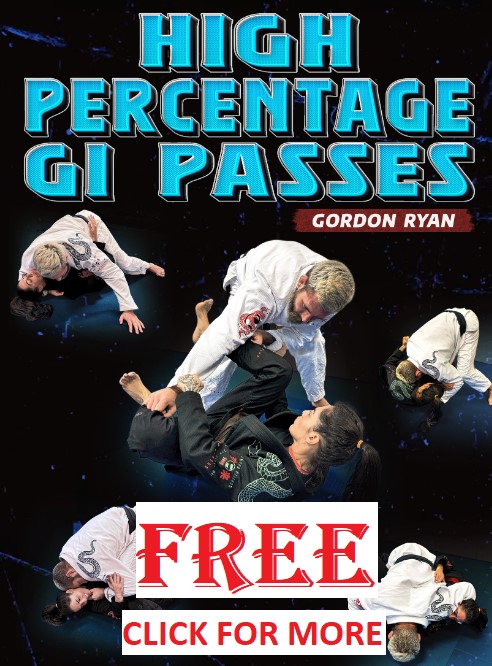
Afraid that pulling guard will get you labeled as a wimp? Before you give in to the pressure of meme culture, ask yourself whether you would rather win a match and fight smart, or care more about gym banter. Learning how to pull guard in Jiu-Jitsu is one of the things that will actually help you develop a better takedown game and make you crazy efficient with your attacks while providing a safety net at the same time. Rethinking your approach to pulling guard?
The Unique Environment Of BJJ Standup Fighting
Brazilian Jiu-Jitsu is a martial art that mostly takes place on the ground. As such, people dedicate immense amounts of time to figuring out the tiniest possible details about positioning, leverage, pressure, movement in terms of ground fighting. However, you then go to a BJJ competition and you’re asked to start standing and get the match to the ground. This standing aspect of the sport, which is a precursor to everything that happens on the ground is very often largely overlooked.
Getting a fight, whether it is a sports match or a violent street encounter is no easy feat to accomplish. Even though many fights go to the ground eventually, you’d be surprised how reluctant people are there to allow you to get them there when they realize what is happening. When those people are also trained in Jiu-Jitsu, that task becomes even more difficult.
With all the focus on ground exchanges, BJJ has taken the lazy way out when it comes to taking a fight to the ground – borrowing techniques from other proven grappling arts like Judo, wrestling, and Sambo. The only problem is that people trained in these arts prepare for years until they’re able to pull off a successful takedown or throw against a trained opponent.
The only BJJ-specific way to get a fight to the ground is to pull the top person on top of you, aiming to get them in your guard. It is a source of much controversy in Jiu-Jitsu which I find to be completely needless. If you truly want to be able to do Jiu-Jitsu, you need to do everything: leg locks, lapel guards, neck cranks, and yes, how to pull guard.
What You Need To Know Before Pulling Guard
Guard pulls are a powerful weapon in Jiu-Jitsu. While you can’t score any points when pulling guard, you can get into a position that will allow you to submit opponents directly, or to look for points by sweeping. Given that the guard is a staple of Jiu-Jitsu, going to that position on purpose should be a no-brainer.
However, it is the approach most people have to pulling guard that complicates things, especially for those that are new to BJJ. The reason is simple – people learn to pull guard first, and what the guard is second. Of course, they’re going to have a difficult time with it and will fail more times than they succeed.
The first thing people need to learn is what a guard is. The closed guard is the perfect example, given that it is the guard most people pull most of the time. So the first thing to learn if you want to effectively pull guard is how to maintain the guard. In the case of the closed guard, it means how to move your torso, how to control the opponent with your legs, where to grip, etc. If you’re not comfortable staying in guard, then you’re not ready to learn how to pull guard.
But wait, there’s more. It is not enough to know how to hold a guard, you also need to have the next step sorted out. Will you sweep, submit or try both? Remember, staying in guard is not enough, there are no points and you can only fight off passing attempts for so long. So, once you know your guard, and how to hold it, you need to pick an attack and get good at it.
Only when you know how to hold a guard and how to attack from one, you can start learning how to pull guard.
How To Pull Guard Safely In Competition
When it comes to pulling guard, there are two key things to keep in mind. The first pone is to pull the guard so that the opponent has no time to react and adjust their position so they start passing the moment you reach the ground. The second one is sport-specific and involves you thinking about grips. If an opponent is holding your leg to attempt takedowns, and you pull guard, the takedown will still be awarded to the other person. As you can see, pulling guard is not as easy as some people think.
Guard Pulling In The Gi
How to pull guard in the Gi? Adhere to 3 key principles and you’ll have the easiest time ever. Skip any one of them, and your chances will greatly subside. It doesn’t matter if you’re pulling an open, closed, or inverted guard. If you complete all three of the following steps you’ll pull guard effortlessly…and then some!
Step 1: Grab something. The best grip combination is holding a sleeve and a collar. it won’t make too much of a difference which collar you’re holding, but the bottom line is that you need a connection to your partner before you decide to pull guard. You can do it by holding just one (collar or sleeve) but having both is preferable.
Step 2: Make sure you use one of your legs to keep the opponent at a distance. You should make sure that the sole of one of your feet is propped somewhere on the opponent’s hips as you are going to the ground. It is not advisable though to grab the grips, put the leg on the hip and try to pull guard by lying straight to your back. Instead, you’ll need to combine this step with step number 3 in order to get the most out of your guard pull.
Step 3: Momentum. There’s no way to pull guard safely and effectively if the opponent is aware of your intentions. Instead, grab the grips, turn your hips so that you lead the opponent to one side, and then use the far leg to post on their hip as you’re twisting your hips to get you to the ground at an angle to the opponent.
This is not just a proven way of pulling guard effectively, but it can also give you the momentum to turn your guard pull into an immediate takedown by ending up on top of your opponent. Moreover, you can pull any guard, closed or open, using these principles. IN fact, you can even jump guard with this setup.
No-Gi Guard Pulls
Pulling guard in No-Gi is a little bit trickier given the lack of grips. Conversely, that is the one thing you need to solve when learning how to pull guard without the Gi. The principles to use are similar to those above, with some slight modifications to take into account the No-gi setting.
Step 1: Establish grips. The grip you want is any variation of the 2 on 1: wrist grab, arm drag, Russian tie, or anything that you find works for you. The goal is to make sure your opponent can’t pull that arm out so that you can force them into your guard. IT also makes fighting for takedowns very uncomfortable given that they’ll need both arms to set up anything that makes sense.
A key point to remember when gripping in No-Gi is to keep your elbows close to your body once you establish the grips.
Step 2: The best way to go to guard in No-Gi is actually sitting down. Do not lie down immediately, but rather focus on sitting down after you establish the grips. As you do, keep pulling your opponent towards you. This makes them try and keep their hips away, which will provide you with plenty of space to get a leg in between you and start implementing your game.
Flying Guard Pull(s)
I am not a big fan of doing crazy stuff on the feet, but there is a flying guard pull variation out there that I like and have done in tournaments: the web guard pull.
The idea behind this is that you’re pulling closed guard, but aligning the front of your hips to the side of the opponent’s, rather than square with them. It requires a collar tie/deep collar grip and depends on you having your gripping arm positioned over the opponent’s arm.
The goal is to jump to a side guard-like position while the opponent is standing. You then take your head below their knees, grab behind the knee and use your weight to topple an opponent forward (force them to do a front roll) ending up in the Spiderweb position. It is a very impressive-looking guard pull that is legal at all levels and works in Gi and No-Gi.
Common Mistakes When Pulling Guard
There are many things people get wrong when they’re trying to figure out how to pull a guard. However, a couple of mistakes that usually prove to be very costly have to do with how you go to the ground, and what you do with your legs once you’re there. After all, the idea is to pul people in guard, not to let people pass.
Mistake #1: Do not fall directly to your back. Instead, look to sit first, or if you go down, do so turning on your side rather than going flat with your back. it makes it really difficult to move when you put both your shoulder blades and buttocks on the ground. Sitting down is the preferred way in which you make contact with the ground when pulling guard in both Gi and No-Gi.
Mistake #2: Not putting your legs between you and the opponent. I already went over this several times, but I’ll stress it again: at least one of your legs needs to be between you and your opponent, preferably with a foot on their hip. However, if you’re pulling an open guard variation, or things are moving extremely fast and you’ve been forced with your back to the ground, make sure both your feet are pointing towards the opponent. This will get you out of most trouble associated with pulling guard in Jiu-Jitsu.
What Comes Next?
So you managed to pull guard. What’s next? Well, that is a question I can only answer in a general fashion – you’ll have to find specific answers on your own. The usual options include sweeping and/or submitting. However, I want to touch on a couple of other subjects that also fall under the “what next” category.
The first one I’d like to mention is the type of guard you decide to pull. In many cases, this will dictate exactly what comes next, whether it is a sweep, submission, or transition to another guard. That said, you can pull pretty much any guard, from closed guard, through half guard, to all the open guards you know of. If your preferred guard is De La Riva, for example, you can pull directly into it and proceed with your usual game. or you could pull closed guard and then transition.
Another thing to keep in mind when pulling guard is momentum. I already touched on it, but let’s expand a bit more. Since you can’t get any points from the bottom, why not use the pull to score a takedown? in many cases, the act of pulling guard can help you off-balance the top person and you can end up getting on top. It goes contrary to what you might picture as pulling guard but it is an opportunity. In fact, it is the best option out there apart from pulling someone directly into a submission.
Final Words
Learning how to pull guard in Jiu-Jitsu is just as important as learning throws and takedowns. It may even be more important as it is actually the only pure BJJ way of taking a match or a fight to the ground. As long as you’re aware of your goals and some key principles, you should have no trouble making the most out of guard pulls.












































